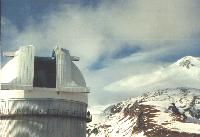Observation sites
The Observatory was planned as an astrometric institution, and its first telescopes were the Wanschaff vertical circle (D=19 cm, F=2.5 m) and the Tepfer–Steingel double long-focus astrograph (D=40 cm, F=5.5 m). The Wanschaff vertical circle was used for determining absolute declination of stars and planets. Most observations are made by night, but the Sun, Venus, Mercury, and few bright stars are observed in the daytime. Observations made with this instrument served as the basis for six catalogues.
Over the years, the field of investigations widened, and new telescopes were installed: the small solar telescope with a spectrograph (1954), the chromospheric telescope (1957), the AZT-2 reflector (D = 70 cm) in 1959, the horizontal solar telescope ATsU-5 (D = 44.5 cm, F = 17 m) in 1965, the Zeiss double wide-angle astrograph (D = 40 cm, F = 2 m) in 1975. The Meridian Axial Circle (1987) is used for highly precision positional observations of celestial objects.
Construction works at the Golosiiv site have gone over the course of its existence: a mechanical workshop was built in 1964, a dome for the double wide-angle astrograph was built in 1975, the main observatory building was constructed in 1976, and the construction of the fine mechanics and optics building and a new dome for the double long-focus astrograph was completed in 1991.
The observatory bases on the Maidanak Mountains (Uzbekistan), Tariha (Bolivia), and the high-altitude Observatory on the Peak of Terskol were built by the GAO's efforts. The astrophysical observatory on Terskol Peak in the Northern Caucasus (altitude 3100 m, near mountain Elbrus) was constructed in 1970−1991 by the Main Astronomical Observatory as its high-altitude observation station. From 1992 this observatory forms a part of the International Centre for Astronomical, Medical and Ecological Research (ICAMER). This Centre was created in 1992 by the National Academy of Sciences of Ukraine, the Russian Academy of Sciences and the Government of Kabardino-Balkaria. It is headed by Dr. V. K. Tarady. The equipment of the Terskol Station consists of the horizontal solar telescope ATsU-26, a specialized solar telescope SEF-1 (D=0.5 m and 0.2 m), the 60-cm reflector telescope, and the 2-meter Ritchey−Chretien coude telescope which was put into operation in 1995.
 |
 |
 |
| The 70 cm reflector AZT-2 | The Tepfer–Steingel double astrograph | Satellite Laser Ranging |
 |
 |
 |
| The 2-m Ritchey-Chretien-Coude Telescope | The Large Horizontal Solar Telescope ATsU-26 | The Zeiss double wide-angle astrograph |
 |
 |
|
| The Meridian Axial Circle | The Horizontal Solar Telescope ATsU-5 |



 COORDINATES
COORDINATES